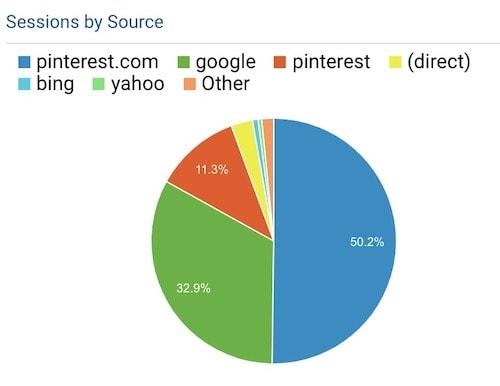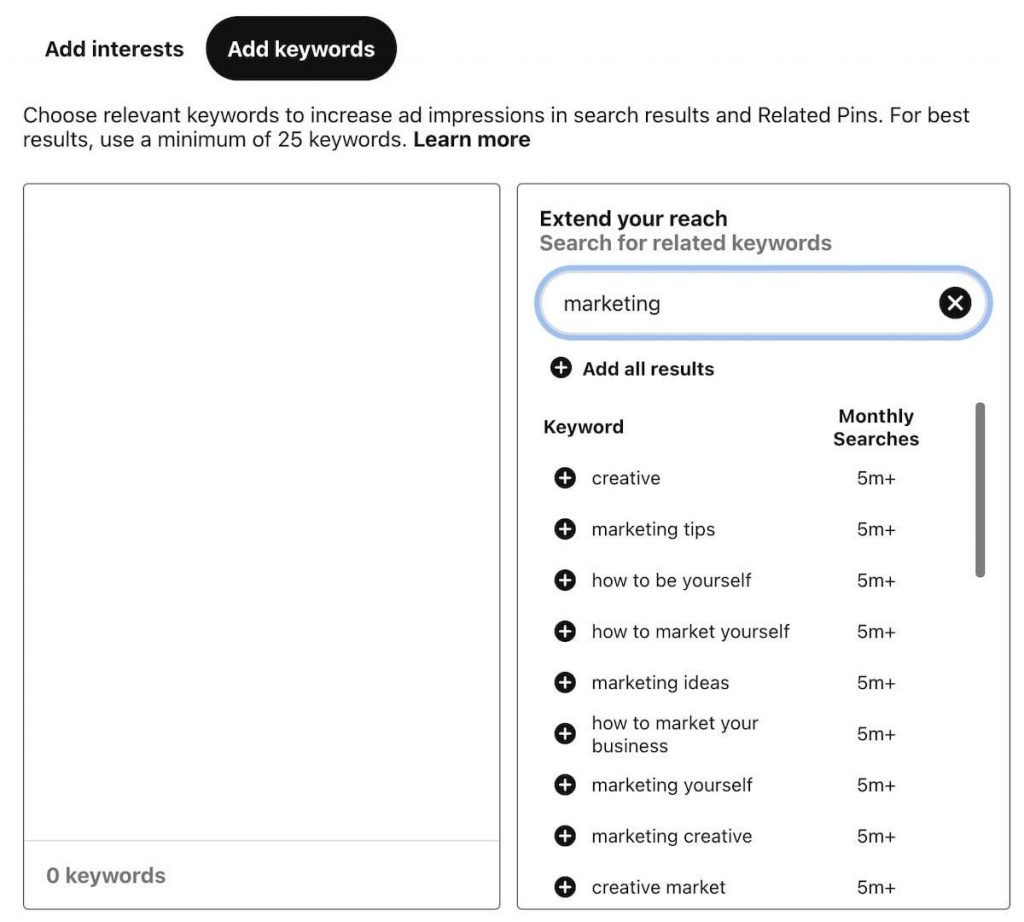Pinterest is one of those platforms that many small business owners and bloggers overlook. This is often due to the misconception that the platform is only used to search for recipes and home decor ideas.
However,
- there are other blog niches that are hugely popular,
- such as fitness,
- DIY,
- finance,
- parenting,
- technology,
- relationships, and coding.There are also more traditional “masculine” brands like Harley Davidson, Art of Manliness, Lowe’s and Dollar Shave Club that use Pinterest as part of their marketing strategy.
In fact, about 61% of traffic to my fitness blog – 7Sigma Physiques – comes from Pinterest.

If you’ve already started a blog, you know how difficult it can be to drive traffic to it, especially if you don’t have the budget for paid ads and are focused on getting free organic traffic.
In this article, we’ll cover why Pinterest is great for bloggers and seven tips for driving more traffic from Pinterest to your blog.
- Why is Pinterest great for increasing blog traffic?
- 7 tips to drive more traffic from Pinterest to your blog
- Pinterest best practices
- Measuring Pinterest results with Supermetrics
- final thoughts
Why is Pinterest great for increasing blog traffic?
Let’s start with a few reasons why Pinterest is so great for bloggers and other small business owners:
- This is a search engine . Most people have the misconception that Pinterest is a social media platform, but it is actually a search engine.
- This means that your content will continue to be found years after it’s posted, rather than disappearing after a few hours like it does on platforms like Facebook, Instagram.
- Easier to sort . Pinterest’s algorithm is not as advanced as Google’s; This means it’s easier and faster to rank for popular keywords.
- The audience consists of high-income users . According to Statista, 27% of adults who use Pinterest earn $30,000-74,999 per year and 41% earn more than $75,000.
People are ready to buy . According to Statista, 47% of Pinterest users make purchasing decisions on Pinterest, which is 15% more than Facebook and 11% more than Instagram, according to Statista.
7 tips to drive more traffic from Pinterest to your blog
Now that we know how Pinterest can benefit your business, let’s take a look at seven concrete tips that will help you drive more traffic from Pinterest to your blog.
1. Do Pinterest keyword research
If you’ve already learned the basics of Google SEO, you’re familiar with the term “keyword research.”
But if you haven’t, keyword research is the process of strategically adding popular search terms that people type into search engines to your content so that they appear higher in search and search results.
Fortunately, Pinterest keyword research is a little simpler than keyword research for Google. Let’s take a look at three techniques you can use to find keywords in your niche:
a) Pinterest search bar
When you start typing any search term related to your blog niche, Pinterest will automatically suggest other frequently searched keywords.
These recommendations are based on what thousands of people on Pinterest are searching for.

In the image above, you can see the following suggestions pop up when I type in the search term “weight loss”:
b) Explore Pinterest
The second technique is to use Pinterest’s discovery page and check what type of content is popular in your niche.

After you click on a topic, Pinterest shows you things like featured articles, trending searches, and popular ideas.
This is a great way to see not
c) Pinterest Ads
To find keywords using Pinterest Ads, log into your Pinterest account and go to Ads > Create ad.
Don’t worry, we’re not actually going to create a campaign. We just want to see more keywords.
Anyway, now in the left column click New ad group > choose any strategy (it doesn’t matter) > click Keywords and Interests > Add keyword.
In the right column, type any keyword for your blog topic. Pinterest automatically shows you relevant keywords and their monthly search volumes.

These keywords are the most popular keywords on Pinterest, with some getting more than 5 million searches per month.
If you run Pinterest Ads, these are the best keywords to use for your campaigns. A great Pinterest analytics guide in case you need help analyzing the performance of your organic and paid Pinterest campaigns.
Monitoring your Pinterest keywords
Now that you’ve found a few keywords, it’s time to write them down as you’ll be using them to create content and optimize your Pinterest account.
You can use any tool you feel comfortable working with. It can be anything, for example:
- Trello boards
- notebooks
- Word
- Google Docs
- Excel
Personally, I like to use Excel spreadsheets to keep track of keywords.
2. Add keywords to your Pin titles and descriptions
After typing in some popular keywords in your niche, it’s time to start your Pin titles and descriptions so they can be found when people search for those terms.
To optimize your Pins, you want to:
- Add the main keyword to the Pin header and description
- Type the keyword in your pin image (Pinterest reads the text placed on the images)
- Don’t forget to include other relevant keywords in your pin description
- Create 2-5 related hashtags at the end of your description
3. Use relevant keywords in your board titles and descriptions
On Pinterest, users can search specifically for Boards to follow, so it’s important to include relevant keywords in your Board titles and descriptions.
The same rules we covered for optimizing Pins above apply to optimizing Boards. The only difference is that you don’t really need to add hashtags (some people argue that you don’t need to add them to Pins).
4. Match the title of your blog post
Pinterest is increasingly like Google. The platform now scans your blog post to see how relevant it is to the Pin linked to it.
Making sure your Pins match the linked content is what Pinterest engineers refer to as Pin matching.
Pinterest wants to make sure a Pin matches the semantics of the webpage. For example, if you post a Pin titled “Green Throw Pillow” and add it to a board titled “Living Room Decor,” Pinterest might expect to see it linked to a retail site with home decor items.
5. Create curiosity with your Pins
One of the best ways to make sure people click through to your blog is to generate interest with your Pin titles and images.
This technique is used not only for Pins, but also for things like email subject lines and blog post titles.
For example, if you wrote an article titled “Foods to avoid for weight loss” and used a donut image on your Pin, not many people would click because it’s pretty obvious that donuts are high in calories.
A better image to use would be something like yogurt, which is generally considered healthy but many of them have tons of added sugar.
Also, using a title like “Healthy foods to gain weight” will arouse more curiosity.
6. Feature your Pins
When it comes to making your Pins stand out, most people give you the same advice: Use bright colors that grab people’s attention.
While it’s true that brighter colors tend to attract more attention, it’s not necessarily a good idea for Pinterest.
This is because if everyone is using bright colors on their Pins, no one will stand out.
A better technique is to look at what Pin designs from bloggers in your niche look like and create something different.
For example, if you’re in the fitness niche and see all Pins as vibrant colors, you can use earth tone color combinations to stand out.
On the other hand, if you see everyone using earth tones, you might turn to something more lively.
7. Apply for Rich Pins
Rich Pins are Pins that automatically pull information from your website to your Pins. This allows users to easily see additional information about your article in close-up, which can increase clickthrough rate.
Rich Pins also syncs information from your blog every time you make changes to your blog post.
For example, if you wrote an article titled “Best roller skates for teens in 2022” and then decide to update this list next year and change the title to “…in 2022”, Rich Pins will automatically update all of your Pins linked to. that blog post with a new title.
Rich Pin Types
There are four different types of Rich Pins:
- Article Rich Pins . These show the title, meta description, and author of the blog post.
- Recipe Rich Pins . These show the title, serving size, cooking time, ratings, and ingredient list.
- Product Rich Pins . Product Rich Pins linking to product pages will display the most up-to-date information on product pricing and availability.
- Application Rich Pins . These Pins display an install button so users can download your app without leaving Pinterest.
How to Apply for Rich Pins
To refer to Rich Pins, you need to add some metadata to your website. This can be done manually or with a plugin.
Doing this manually can be a very complex process, so I will walk you through the steps to do it with two different plugins, one of which you may have installed on your blog.
a) Adding metadata using Open Graph and Twitter Card Tags
All you have to do is login to your WordPress dashboard, install and activate the Open Graph and Twitter Card Tags plugin. In no way do you need to change any settings.
Pretty easy, right?
b) Adding metadata using Yoast SEO
Yoast SEO is one of the most popular SEO plugins available and you are probably using it.
If you are using Yoast SEO, all you have to do is WordPress dashboard > SEO > Social > Click on “Facebook” tab > enable “Add Open Graph metadata” > Save changes.
After enabling Open Graph with any of these methods, you’ll want to clear your cache if you’re using a caching plugin. After clearing your cache, go to Pinterest’s Rich Pin Validator > copy the URL of your blog posts > paste it in the “Enter a valid URL” field > click verify.

This much. If Pinterest was able to find your metadata, you’ll get a message that your Rich Pins have been approved on Pinterest.

Pinterest best practices
Now, let’s take a look at some of Pinterest’s best practices:
- Pin between 1-5 Pins per day . Pinning used to be more useful, but Pinterest has made a few changes to its algorithms and is now focusing more on high-quality and new content.
- Try not to pin the same Pin to the same Board more than once . This could be considered “duplicate content” and could get your account blocked.
- Use a timer . A scheduling tool helps you save time by automating the pinning process.
- Always pin your Pins to the most relevant Board first . For example, if you have a Pin for women about weight loss and a Board titled “Weight Loss”, you should pin it there instead of another Board titled “Fitness.”
- Speed up your website . Speeding up your website will help you lower your bounce rate, increase your conversions, and keep your visitors happy. This is extremely important as most of your Pinterest traffic will come from mobile devices, which may not always have the best connectivity.
Measuring Pinterest results with Supermetrics
Measuring the performance of your Pinterest strategy is crucial to your success on the platform.
In fact, measuring performance is essential for every aspect of growing your blog, whether it’s measuring your email marketing efforts, engagement rate, or guest posting efforts.
You can’t see what works and what doesn’t without tracking your results.
Basically, you can’t improve what you don’t measure.
With Supermetrics, you can easily pull data from your Pinterest account into Google Sheets, Excel, and Google Data Studio to see what type of content is performing best.
This allows you to take a better look at your strategy so that you can make the necessary adjustments.
With Supermetrics’ new Pinterest connectors, you can easily:
- Generate reports with both paid and organic data from Pinterest in Google Sheets, Google Data Studio, and Excel
- See which Pin types are getting the most clicks
- See your follower count grow over time
- Create an ecommerce marketing funnel that lets you correlate your Pinterest Ads performance metrics with your Shopify’s revenue data
- Gather all your Pinterest Ads data into a single dashboard or create a paid channel mix report
- And more…
final thoughts
This much! If you’re planning to drive tons of traffic from Pinterest to your blog without having to spend money on ads, these tips will definitely get you started.
And even if you’re currently using another traffic source like Google, it’s always a good idea to diversify.
We don’t want to put all our eggs in one basket, do we?
You can become a member of our site to grow your Instagram accounts and increase your followers, likes, views and subscribers. Click to see our social media products.

